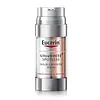What's inside
What's inside
 Key Ingredients
Key Ingredients

 Benefits
Benefits

 Concerns
Concerns

No concerns
 Ingredients Side-by-side
Ingredients Side-by-side

Water
Skin ConditioningButylene Glycol
HumectantNiacinamide
SmoothingGlycerin
HumectantSea Water
HumectantErythritol
HumectantHydroxyacetophenone
Antioxidant1,2-Hexanediol
Skin ConditioningBis-PEG-15 Methyl Ether Dimethicone
EmulsifyingSqualane
EmollientPhenylethyl Resorcinol
AntioxidantTranexamic Acid
AstringentSodium Hyaluronate
HumectantSodium Acrylates Copolymer
Ceramide NP
Skin ConditioningCeramide Ns
Skin ConditioningCeramide As
Skin ConditioningCeramide EOP
Skin ConditioningCeramide AP
Skin ConditioningCentella Asiatica Extract
CleansingArbutin
AntioxidantEctoin
Skin ConditioningAcrylates/C10-30 Alkyl Acrylate Crosspolymer
Emulsion StabilisingAllantoin
Skin ConditioningCaprylic/Capric Triglyceride
MaskingLecithin
EmollientPropanediol
SolventPPG-26-Buteth-26
Skin ConditioningLactobacillus/Rice Ferment Filtrate
Skin ConditioningDisodium EDTA
Hydroxypropyltrimonium Hyaluronate
Methylpropanediol
SolventBeta-Glucan
Skin ConditioningPhormidium Persicinum Extract
AntioxidantTocopherol
AntioxidantPortulaca Oleracea Extract
Skin ConditioningCrocus Sativus Callus Extract
AntioxidantCaprylhydroxamic Acid
Pancratium Maritimum Extract
BleachingFructose
HumectantHydrolyzed Rhodophyceae Extract
Ethylhexylglycerin
Skin ConditioningPhytosterols
Skin ConditioningDisodium Stearoyl Glutamate
CleansingWater, Butylene Glycol, Niacinamide, Glycerin, Sea Water, Erythritol, Hydroxyacetophenone, 1,2-Hexanediol, Bis-PEG-15 Methyl Ether Dimethicone, Squalane, Phenylethyl Resorcinol, Tranexamic Acid, Sodium Hyaluronate, Sodium Acrylates Copolymer, Ceramide NP, Ceramide Ns, Ceramide As, Ceramide EOP, Ceramide AP, Centella Asiatica Extract, Arbutin, Ectoin, Acrylates/C10-30 Alkyl Acrylate Crosspolymer, Allantoin, Caprylic/Capric Triglyceride, Lecithin, Propanediol, PPG-26-Buteth-26, Lactobacillus/Rice Ferment Filtrate, Disodium EDTA, Hydroxypropyltrimonium Hyaluronate, Methylpropanediol, Beta-Glucan, Phormidium Persicinum Extract, Tocopherol, Portulaca Oleracea Extract, Crocus Sativus Callus Extract, Caprylhydroxamic Acid, Pancratium Maritimum Extract, Fructose, Hydrolyzed Rhodophyceae Extract, Ethylhexylglycerin, Phytosterols, Disodium Stearoyl Glutamate
Water
Skin ConditioningAlcohol Denat.
AntimicrobialButylene Glycol
HumectantGlycerin
HumectantOctocrylene
UV AbsorberIsopropyl Palmitate
EmollientCetearyl Isononanoate
EmollientDistarch Phosphate
AbsorbentMethylpropanediol
SolventIsobutylamido Thiazolyl Resorcinol
BleachingSodium Ascorbyl Phosphate
AntioxidantSodium Hyaluronate
HumectantGlycyrrhiza Inflata Root Extract
Skin ConditioningTocopherol
AntioxidantGlucosylrutin
AntioxidantSodium Stearoyl Glutamate
CleansingGlyceryl Stearate
EmollientSodium Polyacrylate
AbsorbentDimethicone
EmollientIsoquercitrin
AntioxidantCitric Acid
BufferingSodium Chloride
MaskingTrisodium EDTA
Caprylyl Glycol
EmollientPhenoxyethanol
PreservativeParfum
MaskingWater, Alcohol Denat., Butylene Glycol, Glycerin, Octocrylene, Isopropyl Palmitate, Cetearyl Isononanoate, Distarch Phosphate, Methylpropanediol, Isobutylamido Thiazolyl Resorcinol, Sodium Ascorbyl Phosphate, Sodium Hyaluronate, Glycyrrhiza Inflata Root Extract, Tocopherol, Glucosylrutin, Sodium Stearoyl Glutamate, Glyceryl Stearate, Sodium Polyacrylate, Dimethicone, Isoquercitrin, Citric Acid, Sodium Chloride, Trisodium EDTA, Caprylyl Glycol, Phenoxyethanol, Parfum
 Reviews
Reviews

Ingredients Explained
These ingredients are found in both products.
Ingredients higher up in an ingredient list are typically present in a larger amount.
Butylene Glycol (or BG) is used within cosmetic products for a few different reasons:
Overall, Butylene Glycol is a safe and well-rounded ingredient that works well with other ingredients.
Though this ingredient works well with most skin types, some people with sensitive skin may experience a reaction such as allergic rashes, closed comedones, or itchiness.
Learn more about Butylene GlycolGlycerin is already naturally found in your skin. It helps moisturize and protect your skin.
A study from 2016 found glycerin to be more effective as a humectant than AHAs and hyaluronic acid.
As a humectant, it helps the skin stay hydrated by pulling moisture to your skin. The low molecular weight of glycerin allows it to pull moisture into the deeper layers of your skin.
Hydrated skin improves your skin barrier; Your skin barrier helps protect against irritants and bacteria.
Glycerin has also been found to have antimicrobial and antiviral properties. Due to these properties, glycerin is often used in wound and burn treatments.
In cosmetics, glycerin is usually derived from plants such as soybean or palm. However, it can also be sourced from animals, such as tallow or animal fat.
This ingredient is organic, colorless, odorless, and non-toxic.
Glycerin is the name for this ingredient in American English. British English uses Glycerol/Glycerine.
Learn more about GlycerinMethylpropanediol is a synthetic solvent and humectant.
As a solvent, it helps dissolve other ingredients, helping to evenly distribute ingredients throughout the product. This ingredient has also been shown to have antimicrobial properties which makes it a preservative booster.
Methylpropanediol is able to add a bit of moisture to the skin. It also helps other ingredients be better absorbed into the skin, such as salicylic acid.
Learn more about MethylpropanediolSodium Hyaluronate is hyaluronic acid's salt form. It is commonly derived from the sodium salt of hyaluronic acid.
Like hyaluronic acid, it is great at holding water and acts as a humectant. This makes it a great skin hydrating ingredient.
Sodium Hyaluronate is naturally occurring in our bodies and is mostly found in eye fluid and joints.
These are some other common types of Hyaluronic Acid:
Learn more about Sodium HyaluronateTocopherol (also known as Vitamin E) is a common antioxidant used to help protect the skin from free-radicals and strengthen the skin barrier. It's also fat soluble - this means our skin is great at absorbing it.
Vitamin E also helps keep your natural skin lipids healthy. Your lipid skin barrier naturally consists of lipids, ceramides, and fatty acids. Vitamin E offers extra protection for your skin’s lipid barrier, keeping your skin healthy and nourished.
Another benefit is a bit of UV protection. Vitamin E helps reduce the damage caused by UVB rays. (It should not replace your sunscreen). Combining it with Vitamin C can decrease sunburned cells and hyperpigmentation after UV exposure.
You might have noticed Vitamin E + C often paired together. This is because it is great at stabilizing Vitamin C. Using the two together helps increase the effectiveness of both ingredients.
There are often claims that Vitamin E can reduce/prevent scarring, but these claims haven't been confirmed by scientific research.
Learn more about TocopherolWater. It's the most common cosmetic ingredient of all. You'll usually see it at the top of ingredient lists, meaning that it makes up the largest part of the product.
So why is it so popular? Water most often acts as a solvent - this means that it helps dissolve other ingredients into the formulation.
You'll also recognize water as that liquid we all need to stay alive. If you see this, drink a glass of water. Stay hydrated!
Learn more about Water